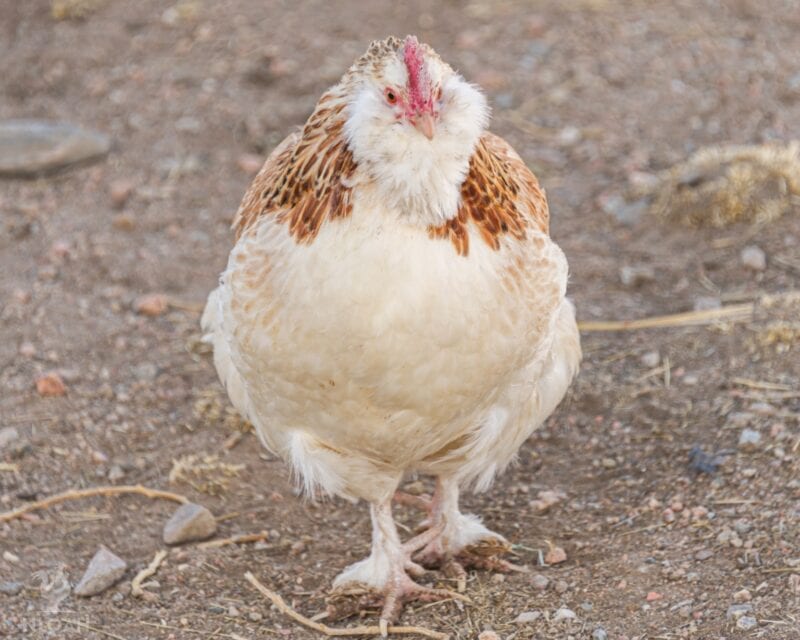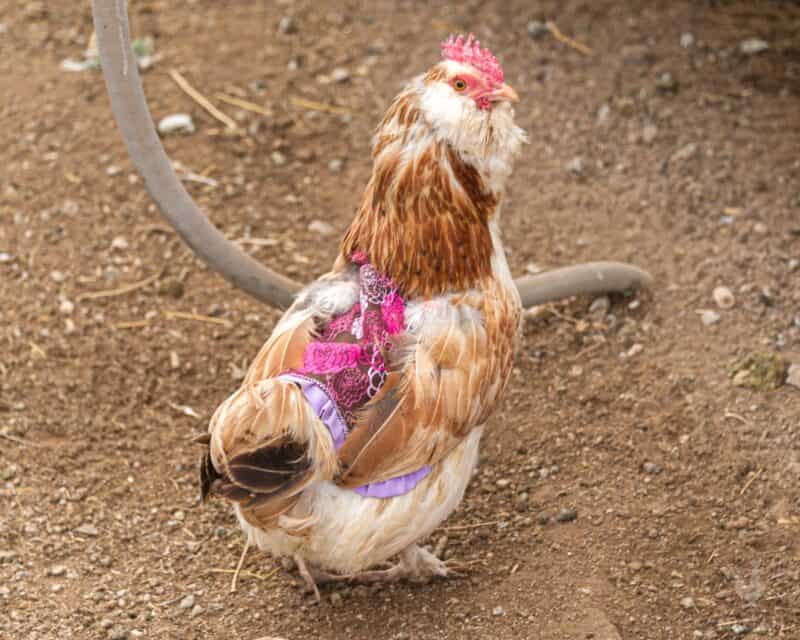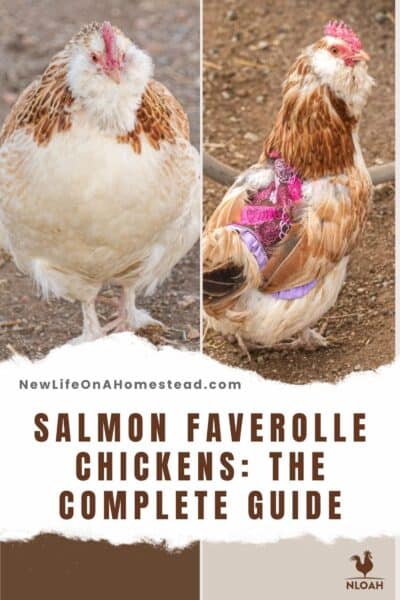Every person who keeps chickens for any length of time will soon develop favorites. Favorite individual birds, yes, but also favorite breeds.

That’s one of the great things about being a chicken fancier: there are so many unique and gorgeous chickens out here to appreciate! So many, in fact, that it can be a little intimidating to know where to start.
From the rare and exotic to the commonplace, dependable standbys we all know and love, there is a perfect breed out there for everyone.
Today will be looking at my absolute favorite, the Salmon Faverolles. With a personality that is second to none and gorgeous plumage to match, this French heritage breed is still a very capable and practical performer on the homestead.
Grab a seat and I’ll tell you all about them!
What are Salmon Faverolles?
The Salmon Faverolles is a French heritage breed of chicken that is known for its uniquely colored plumage, friendly and inquisitive behavior, tolerance of long periods of close confinement, and dependable egg production. Today they’re kept predominantly as ornamental birds and pets.
History of the Breed
The Salmon Faverolles has a seemingly humble origin, but today it enjoys a reputation as a distinguished heritage breed.
Way, way back, the Salmon Faverolles was originally developed to replace the then most common commercial chicken in French circulation, the Houdan. Houdans were good producers of meat and eggs, but problems arose when people tried to transport them over long distances.
The birds would become gravely stressed in close confinement, with many developing illnesses, showing elevated stress, and even dying.
Hailing from a village in lower Normandy that shares its name, Faverolles, historians suspect that these birds were developed from a combination of Brahma, Rennes, Malines, Dorking, and Houdan stock.
I say suspect because the precise origins and progenitors of these birds have been lost to the march of time. Nonetheless, this is a breed that is inextricably linked with French identity.
What is the Breed Standard for Salmon Faverolles?
According to the APA, American Poultry Association, we have guidelines for both standard and bantam Salmon Faverolles.
The Salmon Faverolles is classified as a continental chicken, has a trapezoidal body with a broad, deep breast, and a weight specified at 8 pounds for roosters and six and a half pounds for hens. The standard for bantams is, of course, much lighter at 30 ounces for roosters and 26 ounces for hens.
They have a single, five-pointed red comb, small red wattles, and reddish eyes that are what’s known as a bay color. The beak is either horn or pink.
Males and females have prominent beards and muffs, though they are noticeably thicker and shaggier on males. Salmon Faverolles naturally have polydactyly, and have five toes on each foot. The legs are feathered.
The APA only recognizes the quintessential salmon coloration and pure white. Notably, white was not accepted as part of the breed standard until the early 1980s. The salmon color was recognized in the mid-1910s shortly after the breed arrived on US shores.
In any case, the underfluff is a gray or off-white color, and all plumage is fluffy, dense, and loose against the body.
Typical Size and Weight of Salmon Faverolles
Salmon Faverolles are properly classified as medium-weight chickens, with males usually weighing about 8 pounds or a little bit more, and females about 6 ½ pounds at most.
As mentioned above bantams are quite a bit lighter, with roosters weighing just two and a half pounds and hens weighing just a hair over 2 pounds.
Note that the fluffy, puffy plumage of the Salmon Faverolles makes them look bigger than they really are, and accordingly they don’t weigh as much as you might suspect at first glance.
What Colors of Plumage Do Salmon Faverolles Chickens Come In?
If a Faverolles chicken is a Salmon Faverolles, it comes in the distinctive and completely unique salmon color. This color is a speckled tan, sienna, buff, and brown which gives it an almost orange color that looks very much like the raw flesh of a salmon.
Other colors are pure white, the only other accepted standard color in the United States, along with blue and black which are known but not accepted.
Note that the plumage of roosters and hens differs significantly, with females being predominantly white or off-white all over, with sparse patches of salmon coloring on the sides of their necks and shoulders and elsewhere on their bodies.
Roosters, on the other hand, are downright magnificent, with bold black beards and feathers running down their chest and along their underside complimenting their darker and larger patches of salmon. Their tails are an intermingled black, salmon, white, and iridescent beetle green.
Another nNoteworthy is the fact is that Salmon Faverolles are the only chickens that possess this unique salmon coloration: no other birds breed can lay claim to it!.Truly, these are some of the most picturesque chickens you will ever see!
What Are They Good For?
Today, owing to their rarity, Salmon Faverolles are kept predominantly as ornamental birds or by chicken fanciers who appreciate their unique temperament and good looks. They’re extremely popular on show circuits in Europe, and increasingly so in the United States.
They’re also well regarded as a true pet chickens, being extremely friendly, good with people, generally docile, and forming close bonds with owners.
If you’d like a bird that will sit in your lap while you have a nice chat with it, the Salmon Faverolles are among the very best, though they’re highly energetic and always eager to exercise and explore.
However, these chickens are also capable utility birds, producing large quantities of fine, rich meat and plenty of eggs every year.
Temperament
Salmon Faverolles are a truly remarkable bird when it comes to behavior. Though they are known for docility and friendliness with owners, but they swing between periods of serene activity and relaxation and highly energetic, focused explorations.
It’s hardly uncommon to see Salmon Faverolles running around the yard as if on a mission, commonly banging into each other and people before dashing off, continuing on their way.
Nonetheless, they tolerate handling and petting well, and as mentioned tend to form close bonds with owners especially if they are plied with treats and affection.
Salmon Faverolles are also a remarkably good breed if you have small children: They are patient, friendly, and seem to be as curious about kids as kids are about them. With the rare exception of particularly hard-charging roosters, males and females alike can be expected to be kind and courteous with their human family.
Another thing to keep in mind is that this breed was specially developed to tolerate close confinement…
What this means is that, if they must be shut up in a coop for longer periods of time, they can be expected to do very well, and they rarely get stressed out when kept in a cage or pet carrier for transport or quarantine. This is one of the most even-tempered breeds you are likely to find.
However, this does come with a significant downside: aside from their franticness, they tend to be very agreeable and almost timid, and this means they often wind up at or near the bottom of the pecking order in mixed flocks.
If you have any aggressive chickens or known bullies in the flock, is highly likely they will pester the poor Salmon Faverolles nearly to death, so you’ve got to keep an eye out for that.
Rooster Aggression
Compared to other roosters, Salmon Faverolles are not particularly aggressive, but they are protective of hens. They’re also notably more attentive and gentle with hens compared to other breeds, meaning they are less likely to rough them up during mating or at any other time.
When it comes to defending your flock from predators, Salmon Faverolles will put up a fight but aren’t known to be particularly ferocious.

Noisiness
Salmon Faverolles sort of occupy two extremes when it comes to the noise factor. Hens often cluck, peep, and jitter among themselves throughout the day especially when they are excited or out on an adventure, though this is generally soft and unlikely to cause any major disturbance.
Roosters are not known for constant crowing, but they do crow, and they have a distinctively deep, bassy call that is quite loud compared to other birds of similar size. This means they might be highly problematical in settings where noise could cause trouble with the neighbors or family members!
Are These Chickens Good Layers?
Yes, they are. Faverolles are dependably good to very good layers, although they don’t quite stack up to some superlayer birds like Australorps.
A typical Salmon Faverolles hen will crank out about 200 eggs a year on average, with some hens laying a little less and maxing out around 175 and some exceptional individual birds reaching about 240 eggs. Plan on getting about 4 eggs a week, though as a safe bet.
Again, although this isn’t world-beating anymore it is still remarkably good for a chicken that is nominally raised as a meat bird and even better for one that is considered an ornamental or pet breed.
Eggs are anywhere from medium to large depending on the individual hen.
Also, Salmon Faverolles are pretty tolerant of cold weather, and most hens will lay straight through the winter. However, adding a light source to the coop can stimulate and promote winter laying if necessary under which conditions they will lay reliably.
When Do They Start Laying?
Your typical Faverolles hen will begin laying at around 5 months of age, some slightly earlier and others slightly later but that is a good benchmark that you can depend on.
What Color Eggs Do Salmon Faverolles Lay?
Salmon Faverolles eggs range from a pastel pink to a light brown or tan in color. Occasionally, individual eggs or certain individual hens will lay cream or off-white eggs.
Broodiness
Salmon Faverolles are moderately broody, although there is a lot of variation between individual hens. There are dependable and careful setters and doting mothers, and the roosters contribute to the well-being of hens and chicks once they start to feather out.
If you don’t want your girls to sit and hatch, and would rather them keep on laying, know that Salmon Faverolles are fairly easy to break of broodiness.
How Long Do Salmon Faverolles Chickens Usually Live?
A good long life for a Salmon Faverolles is 7 years, though some live slightly longer. As a rule of thumb, expect these birds to live between five and seven years.
This is about average for a chicken across most breeds.
What Do Salmon Faverolles Chickens Eat?
Salmon Faverolles eat the same things that all other chickens eat. The first and majority component of their diet should be a nutritionally complete chicken feed supplemented by grit and also a well-rounded diet of nutritious, whole foods.
This can be things like grains, fruits, veggies, insects, various plants, and so forth. If you have a healthy and bountiful property, your Salmon Faverolles can provide much of this themselves through foraging, as they tend to be highly active, exploratory, and curious and they are capable if not excellent hunters.
And, as always, make sure you provide grit for your flock if they don’t have sand, tiny gravel, and other bits of rock and natural hard material to eat elsewhere on your property.
Any Special Health Concerns These Birds Need to Worry About?
Not really. Considering the excellent breeding and diverse lineage of the Salmon Faverolles they have proven to be remarkably healthy all around, and are not more prone to any common chicken diseases and ailments.
However, their thick and luxurious plumage, and particularly their beards, muffs, and feathered legs make them more vulnerable to mites, fleas, lice, and other external parasite infestations.
This will demand more regular and thorough checking from you to ensure their health and freedom from these critters. Likewise, it’s important to keep the coop, run, and other areas clean and maintained to help reduce populations and the possibility of infestation.
As always, making sure your chickens have access to a good dust bath will go a long way to prevent most problems, and if required, you can treat them with insecticidal dust to dislodge the critters.
Common Predators of Salmon Faverolles
Salmon Faverolles will be the targets of all the usual suspects when it comes to chicken predators. Eggs and chicks will be targeted by snakes, mice, and rats. Large animals like dogs, coyotes, wolves, raccoons, badgers, and so forth can hurt or kill adult birds.
And speaking of birds, birds of prey including hawks, falcons, eagles, and owls will always be a mess, so if you live in an area with large populations you should definitely consider overhead net covering on the run to protect them.
Be sure to “coyote-proof” the run and coop, and seal up small cracks and openings, especially around windows and vents to prevent infiltration by small rodents and snakes.
Is the Faverolles the Right Chicken for You?
Is the Salmon Faverolles the right chicken for you? If you desire a uniquely gorgeous chicken with a storied pedigree, and one that is still a viable utility bird, you won’t go wrong assuming you can find them…
They are still considered a rare breed and although their popularity is spiking in the US you might have to look a little harder and search a little farther to track down a good hatchery or breeder.
If you want friendly, plucky, and entertaining chickens that still have a genuinely sweet and calm disposition, the Salmon Faverolles is second to none.
Pretty much every owner I know that has them talks and talks about them at length, and I always look forward to seeing my own get up to their usual antics!
In many ways, they can be the ideal pet breed.
Frequently Asked Questions
Are Salmon Faverolles chickens rare?
Yes. The Livestock Conservancy has them currently listed as “threatened.” This isn’t critically endangered, but nonetheless, these birds remain pretty rare in the US compared to other breeds.
Are Salmon Faverolles chickens friendly?
Yes, they are! In fact, they are famous for being friendly. They tend to be inquisitive and interested in people, and form close bonds with owners.
Are Salmon Faverolles actually pink?
No. The salmon color of the Salmon Faverolles is not actually pink, but appears more like a dappled orange-brown color.
Are Salmon Faverolles noisy?
Moderately so. Hens like to cluck and chatter continually among themselves regularly, and though roosters do not crow more often than most other breeds as a rule they have a deep, loud call that will get your attention.

Tom has lived and worked on farms and homesteads from the Carolinas to Kentucky and beyond. He is passionate about helping people prepare for tough times by embracing lifestyles of self-sufficiency.
